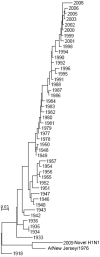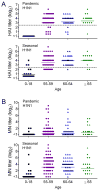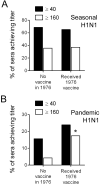Recipients of vaccine against the 1976 "swine flu" have enhanced neutralization responses to the 2009 novel H1N1 influenza virus
- PMID: 20415539
- PMCID: PMC2946351
- DOI: 10.1086/652441
Recipients of vaccine against the 1976 "swine flu" have enhanced neutralization responses to the 2009 novel H1N1 influenza virus
Abstract
BACKGROUND. The world is facing a novel H1N1 influenza pandemic. A pandemic scare with a similar influenza virus in 1976 resulted in the vaccination of nearly 45 million persons. We hypothesized that prior receipt of the 1976 "swine flu" vaccine would enhance immune responses to the 2009 novel H1N1 influenza strain. METHODS. A prospective, volunteer sample of employees aged > or = 55 years at a children's cancer hospital in August 2009 was assessed for antibody responses to the 2009 pandemic H1N1 influenza virus and the 2008-2009 seasonal H1N1 influenza virus. RESULTS. Antibody responses by hemagglutination-inhibition assay were high against both the seasonal influenza virus (89.7% had a titer considered seroprotective) and pandemic H1N1 influenza virus (88.8% had a seroprotective titer). These antibodies were effective at neutralizing the seasonal H1N1 influenza virus in 68.1% of participants (titer > or = 40), but only 18.1% had detectable neutralizing titers against the pandemic H1N1 influenza virus. Of 116 participants, 46 (39.7%) received the 1976 "swine flu" vaccine. Receipt of this vaccine significantly enhanced neutralization responses; 8 (17.4%) of 46 vaccine recipients had titers > or = 160, compared with only 3 (4.3%) of 70 who did not receive the vaccine (P = .018 by chi(2) test). CONCLUSIONS. In this cohort, persons aged > or = 55 years had evidence of robust immunity to the 2008-2009 seasonal H1N1 influenza virus. These antibodies were cross-reactive but nonneutralizing against the 2009 pandemic H1N1 influenza strain. Receipt of a vaccine to a related virus significantly enhanced the neutralization capacity of these responses, suggesting homologous vaccination against the 2009 pandemic H1N1 influenza virus would have a similar effect.
Conflict of interest statement
All authors declare no competing interests.
Figures



References
-
- Perez-Padilla R, de la Rosa-Zamboni D, Ponce de Leon S, Hernandez M, Quinones- Falconi F, et al. Pneumonia and Respiratory Failure from Swine-Origin Influenza A (H1N1) in Mexico. N Engl J Med. 2009;361:680–689. - PubMed
-
- Potter CW. Chronicle of influenza pandemics. In: Nicholson KG, Webster RG, Hay AJ, editors. Textbook of Influenza. London: Blackwell Scientific Publications; 1998. pp. 3–18.
-
- Kumar A, Zarychanski R, Pinto R, Cook DJ, Marshall J, et al. Critically ill patients with 2009 influenza A(H1N1) infection in Canada. JAMA. 2009;302:1872–1879. - PubMed
-
- Dominguez-Cherit G, Lapinsky SE, Macias AE, Pinto R, Espinosa-Perez L, et al. Critically Ill patients with 2009 influenza A(H1N1) in Mexico. JAMA. 2009;302:1880–1887. - PubMed
Publication types
MeSH terms
Substances
Grants and funding
LinkOut - more resources
Full Text Sources
Medical

